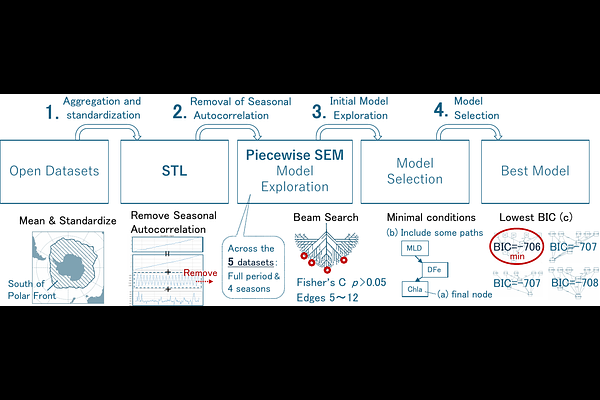Revealing Long-Term Multi-Factor Climate Impacts on Antarctic Phytoplankton: A Trend-Based Approach Using STL and Piecewise SEM

Revealing Long-Term Multi-Factor Climate Impacts on Antarctic Phytoplankton: A Trend-Based Approach Using STL and Piecewise SEM
Tanaka, H.; Doi, H.; Iritani, R.
AbstractClimate change imposes multiple interacting stressors on ocean ecosystems. The Southern Ocean is among the regions where these impacts are particularly pronounced. Phytoplankton, which perform the bulk of primary production, both maintain the Antarctic marine food web and contribute to the role of the Southern Ocean as the largest oceanic sink for atmospheric CO2. Previous observational and modeling studies have revealed certain drivers-phytoplankton relationships and highlighted the important confounding factors. In this study, we quantified how climate and environmental drivers interact and influence phytoplankton biomass over a 20-year period, across the entire Southern Ocean, within a multi-factor framework. Specifically, we examined the relationships among atmospheric CO2, surface water pH, sea ice concentration, sea surface temperature, mixed layer depth, dissolved iron concentration, and chlorophyll a concentration. To perform this analysis, we introduced and applied two novel methodological approaches. Firstly, to address seasonal autocorrelation, we combined seasonal trend decomposition using LOESS (STL) with piecewise structural equation modeling (SEM). This approach allowed for robust estimation of long-term driver magnitudes and causal pathways, even in the presence of limited sample sizes and complex data structures. Secondly, given the highly interconnected nature of environmental drivers, we employed a data-driven SEM approach to objectively identify causal structures and avoid biases associated with a priori pathway selection. Our results show a clear signal of ocean acidification driven by increasing CO2, iron limitation of phytoplankton biomass during spring, and seasonal differences in both the magnitude and structure of the causal pathways, demonstrating the dynamic nature of seasonal processes in the Southern Ocean. This study presents the first Southern Ocean-wide, multi-factor assessment of climate and environmental impacts on phytoplankton biomass over a two-decade period. It introduces a methodological framework mitigates seasonal autocorrelation to accurately capture long-term seasonal trends, and demonstrates the utility of data-driven causal discovery in resolving complex ecological interactions.